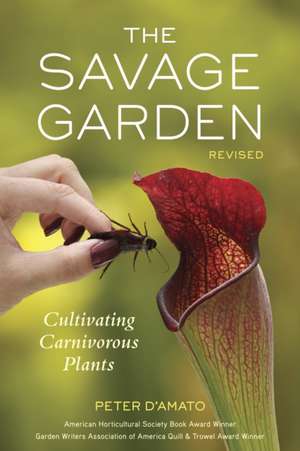The Savage Garden
Autor Peter D'Amatoen Limba Engleză Paperback – 23 iul 2013
You may be familiar with the Venus flytrap, but did you know that some pitcher plants can—and do—digest an entire rat? Or that there are several hundred
species of carnivorous plants on our planet? Beautiful, unusual, and surprisingly easy to grow, flesh-eating plants thrive everywhere from windowsills to outdoor container gardens, in a wide variety of climates. The Savage Garden is the most comprehensive guide to these fascinating oddities, gloriously illustrated with more than 200 color photos. Fully revised with the latest developments in the carnivorous plant world, this new edition includes:
• All the basics—from watering and feeding to modern advances in artificial lighting, soil, and fertilizers.
• Detailed descriptions of hundreds of plants, including many of the incredible new species that have been recently discovered and hybridized.
• Cultivation and propagation information for all the plant families: pitcher plants, Venus flytraps, sundews, rainbow plants, bladderworts, and many other peculiar plants from the demented mind of Mother Nature.
Whether you’re a beginner with your first flytrap or an expert looking for the latest exotic specimen, this classic book has everything you need to grow your very own little garden of horrors.
Preț: 130.17 lei
Preț vechi: 150.50 lei
-14% Nou
Puncte Express: 195
Preț estimativ în valută:
24.91€ • 25.91$ • 20.88£
24.91€ • 25.91$ • 20.88£
Carte disponibilă
Livrare economică 20-27 februarie
Livrare express 05-11 februarie pentru 66.92 lei
Preluare comenzi: 021 569.72.76
Specificații
ISBN-13: 9781607744108
ISBN-10: 1607744104
Pagini: 374
Ilustrații: 200+ Colour Photos
Dimensiuni: 140 x 239 x 25 mm
Greutate: 0.89 kg
Ediția:Revised
Editura: Ten Speed Press
ISBN-10: 1607744104
Pagini: 374
Ilustrații: 200+ Colour Photos
Dimensiuni: 140 x 239 x 25 mm
Greutate: 0.89 kg
Ediția:Revised
Editura: Ten Speed Press
Notă biografică
PETER D’AMATO has been growing carnivorous plants for nearly forty years and his nursery, California Carnivores (CaliforniaCarnivores.com), houses the world’s largest collection of carnivorous plants. D’Amato is cofounder of the Bay Area Carnivorous Plant Society and he lectures on the subject nationwide.
Extras
Preface
I find it ironic that this introduction to the revised edition of The Savage Garden is the final section of the book I am completing, only one week after returning from the 2012 International Carnivorous Plant Society (ICPS) conference hosted by the New England Carnivorous Plant Society. I had a wonderful time at the conference, and in a presentation I gave, I briefly told the audience some details of this new edition. The irony is that at the very first world conference of the ICPS, held at the Atlanta Botanical Garden in 1997, I gave a slide show preview of the first edition of the book. Little did I truly comprehend at the time the potential impact of the book. It won the American Horticultural Society’s book award in 1999 and became a best seller in the genre, and only two weekends ago in New England I autographed dozens of copies for attendees of the conference. Nearly all of the books were well worn, well read, many with colorful bits of paper bookmarking sections of the book important to the reader—well, I was humbled and pleased.
The Savage Garden was not just a coffee table book of pretty pictures, but a resource that people actually read for the helpful information it contained. It was the type of book I wish had existed when I was a kid in the late 1960s, when carnivorous plants first took hold of my life, yet information on them—especially how to grow them—was sorely lacking.
There have been many ICPS conferences since 1997 all over the world, from Japan to Australia, from Europe to North America. The one this past month in New England was startling not only for the amazing show of fantastically beautiful carnivorous plants on display and for sale, but also for the delightful variety of people attending. Adults and kids, men and women, boys and girls—things have certainly changed since I was a teenager—when you could count on one hand the serious growers of carnivorous plants in the United States. Since then, thousands of people all over the world have found the hobby an intoxicating experience. Carnivorous plants are educational, sometimes challenging, utterly and strangely beautiful, and a lot of fun to grow! Plus, unlike other plants—they don’t just sit there!
So how does this revision differ from the first edition? A lot has happened in fifteen years.
Most of the cultivation information has remained primarily intact, but I have tweaked and fine-tuned many details learned over the years. Much of this has come from customers of my nursery, California Carnivores, who have done things unimaginable a decade and a half ago. Other changes came from continual experiments at our nursery, resulting in adjustments to soil recipes, or discovering the cold and freeze tolerance of various subtropical plants. The results were often surprising.
Perhaps the greatest changes have occurred in the identification of many of the plants and the astounding numbers of new species discovered and brought into cultivation in the past fifteen years.
When I first wrote The Savage Garden, for example, most of the varieties of Sarracenia, the American pitcher plants, had nicknames only, such as “red tube” or “coppertop” or “okee giant.” All of these plants, and many new ones discovered and cultivated since, now have true names (see Registered Cultivars, page 357).
The vast number of new species that have been discovered and identified is truly amazing. When I first wrote the book, there were five known species of South American sun pitchers (Heliamphora). Now, the count is approaching twenty-five! The butterworts (Pinguicula) have jumped from seventy species to more than one hundred. And when I first wrote the book there were around eighty species of tropical pitcher plants (Nepenthes) known—the count is now approaching one hundred fifty—with many more expected to be discovered as modern-day enthusiasts climb the countless unexplored mountains from the Philippines to New Guinea. More carnivorous plants have been discovered in the last decade than at any time in the past.
I have also updated some technological advances, like the invention of polycarbonate greenhouse glazing, which is far superior to fiberglass and glass. Grow light technology has also improved greatly, with far superior artificial lights on the market. We have discovered a new fertilizer that doesn’t kill live sphagnum moss, and many new insecticides—some completely natural—that can control bothersome pests with no harm to plants or people.
I have also added the metric system to the revision—a tedious effort that nearly drove me insane. Please keep in mind these systems of measurements are rough and approximate!
I want to thank my business partner, Damon Collingsworth, for taking on the task of coordinating all the photographs for the book. He took dozens of new photos at our nursery and solicited many others from our friends both near and far. As just one example, the photography of plant autopsies, taken by California Carnivores volunteer Patrick Hollingsworth, is unsurpassed. And the astounding images lent to us by naturalists like Ch’ien Lee, Fernando Rivadavia, Stewart McPherson, Barry Rice, and Andreas Fleischman are certainly compelling and hypnotic.
I must end this preface to a book on a topic that has brought so much joy to so many people around the world with a message of sadness and pain.
After the recent conference in New England, many of the attendees went on field trips to see carnivorous plants in the wild. They saw local bogs in New England as well as sites in New Jersey, North Carolina, and the Gulf Coast of southeastern North America, where more species of carnivorous plant genera exist than anywhere else in the world. The excitement of seeing several habitats in protected, pristine beauty was unfortunately overshadowed by one heartbreaking fact: these astounding forms of life are disappearing from our planet at a rate that is beyond alarming.
As a few examples, I went to southern New Jersey to see a couple of my favorite sites I knew as a kid growing up on the Jersey shore. Both of these habitats had originally been bogs in the 1800s, but the slow-moving streams had been dammed to create lake reservoirs for drinking water by the early 1900s. Still, there were vast numbers of surviving plants along the edges of the lakes when I was a kid. Apparently, however, the dams were rebuilt in the past decade, and when I saw them a couple of weeks ago, the enormous quantity of sphagnum moss, pitcher plants, and sundews I remembered were virtually all gone, drowned by the higher lake levels the new dams created. And this was in the Pinelands National Reserve, which “protects” an amazing 22 percent of the small and densely populated state of New Jersey.
Around Wilmington, North Carolina, we saw some very nice, small sites on Nature Conservancy property that is well managed with controlled burns and protected by a locked gate across the road. However, beyond that, we were left having to hunt for plants along dismal drainage ditches along the sides of roads where occasional patches of Venus flytraps, sundews, and pitcher plants barely survived among broken bottles and discarded fast-food containers.
In fact, the most Venus flytraps we saw were in the back yard lawn of a kindly old gentleman who loved and protected the pitcher plants, flytraps, and sundews that survived on the edge of his lakefront property. Originally the area was a vast bog of carnivorous and other rare plants. A few decades ago the creek that drained the bog was dammed, a large lake flooded the bog, and lovely estates were built along the lake. The few plants that survived now grow in grassy lawns, if they are not removed by the homeowner.
A simple ditch dug one or two feet (0.3ߝ0.6 m) deep along the edge of a wet carnivorous plant habitat can drain vast areas, killing off all the plants that rely on wet soils. As Mark Todd, our host in Wilmington and member of the North American Sarracenia Conservancy (http://nasarracenia.org), told us, “There are just fewer and fewer habitats where the plants are able to grow.” And sadly, this is occurring all around the world.
Thankfully, many readers of The Savage Garden first encounter the book to find out how to grow a Venus flytrap or pitcher plant they’ve rescued from a local nursery. If this is the case for you, I hope that your initial interest will grow and evolve, leading you to support the various organizations that are trying to save these wonders of nature from extinction.
I find it ironic that this introduction to the revised edition of The Savage Garden is the final section of the book I am completing, only one week after returning from the 2012 International Carnivorous Plant Society (ICPS) conference hosted by the New England Carnivorous Plant Society. I had a wonderful time at the conference, and in a presentation I gave, I briefly told the audience some details of this new edition. The irony is that at the very first world conference of the ICPS, held at the Atlanta Botanical Garden in 1997, I gave a slide show preview of the first edition of the book. Little did I truly comprehend at the time the potential impact of the book. It won the American Horticultural Society’s book award in 1999 and became a best seller in the genre, and only two weekends ago in New England I autographed dozens of copies for attendees of the conference. Nearly all of the books were well worn, well read, many with colorful bits of paper bookmarking sections of the book important to the reader—well, I was humbled and pleased.
The Savage Garden was not just a coffee table book of pretty pictures, but a resource that people actually read for the helpful information it contained. It was the type of book I wish had existed when I was a kid in the late 1960s, when carnivorous plants first took hold of my life, yet information on them—especially how to grow them—was sorely lacking.
There have been many ICPS conferences since 1997 all over the world, from Japan to Australia, from Europe to North America. The one this past month in New England was startling not only for the amazing show of fantastically beautiful carnivorous plants on display and for sale, but also for the delightful variety of people attending. Adults and kids, men and women, boys and girls—things have certainly changed since I was a teenager—when you could count on one hand the serious growers of carnivorous plants in the United States. Since then, thousands of people all over the world have found the hobby an intoxicating experience. Carnivorous plants are educational, sometimes challenging, utterly and strangely beautiful, and a lot of fun to grow! Plus, unlike other plants—they don’t just sit there!
So how does this revision differ from the first edition? A lot has happened in fifteen years.
Most of the cultivation information has remained primarily intact, but I have tweaked and fine-tuned many details learned over the years. Much of this has come from customers of my nursery, California Carnivores, who have done things unimaginable a decade and a half ago. Other changes came from continual experiments at our nursery, resulting in adjustments to soil recipes, or discovering the cold and freeze tolerance of various subtropical plants. The results were often surprising.
Perhaps the greatest changes have occurred in the identification of many of the plants and the astounding numbers of new species discovered and brought into cultivation in the past fifteen years.
When I first wrote The Savage Garden, for example, most of the varieties of Sarracenia, the American pitcher plants, had nicknames only, such as “red tube” or “coppertop” or “okee giant.” All of these plants, and many new ones discovered and cultivated since, now have true names (see Registered Cultivars, page 357).
The vast number of new species that have been discovered and identified is truly amazing. When I first wrote the book, there were five known species of South American sun pitchers (Heliamphora). Now, the count is approaching twenty-five! The butterworts (Pinguicula) have jumped from seventy species to more than one hundred. And when I first wrote the book there were around eighty species of tropical pitcher plants (Nepenthes) known—the count is now approaching one hundred fifty—with many more expected to be discovered as modern-day enthusiasts climb the countless unexplored mountains from the Philippines to New Guinea. More carnivorous plants have been discovered in the last decade than at any time in the past.
I have also updated some technological advances, like the invention of polycarbonate greenhouse glazing, which is far superior to fiberglass and glass. Grow light technology has also improved greatly, with far superior artificial lights on the market. We have discovered a new fertilizer that doesn’t kill live sphagnum moss, and many new insecticides—some completely natural—that can control bothersome pests with no harm to plants or people.
I have also added the metric system to the revision—a tedious effort that nearly drove me insane. Please keep in mind these systems of measurements are rough and approximate!
I want to thank my business partner, Damon Collingsworth, for taking on the task of coordinating all the photographs for the book. He took dozens of new photos at our nursery and solicited many others from our friends both near and far. As just one example, the photography of plant autopsies, taken by California Carnivores volunteer Patrick Hollingsworth, is unsurpassed. And the astounding images lent to us by naturalists like Ch’ien Lee, Fernando Rivadavia, Stewart McPherson, Barry Rice, and Andreas Fleischman are certainly compelling and hypnotic.
I must end this preface to a book on a topic that has brought so much joy to so many people around the world with a message of sadness and pain.
After the recent conference in New England, many of the attendees went on field trips to see carnivorous plants in the wild. They saw local bogs in New England as well as sites in New Jersey, North Carolina, and the Gulf Coast of southeastern North America, where more species of carnivorous plant genera exist than anywhere else in the world. The excitement of seeing several habitats in protected, pristine beauty was unfortunately overshadowed by one heartbreaking fact: these astounding forms of life are disappearing from our planet at a rate that is beyond alarming.
As a few examples, I went to southern New Jersey to see a couple of my favorite sites I knew as a kid growing up on the Jersey shore. Both of these habitats had originally been bogs in the 1800s, but the slow-moving streams had been dammed to create lake reservoirs for drinking water by the early 1900s. Still, there were vast numbers of surviving plants along the edges of the lakes when I was a kid. Apparently, however, the dams were rebuilt in the past decade, and when I saw them a couple of weeks ago, the enormous quantity of sphagnum moss, pitcher plants, and sundews I remembered were virtually all gone, drowned by the higher lake levels the new dams created. And this was in the Pinelands National Reserve, which “protects” an amazing 22 percent of the small and densely populated state of New Jersey.
Around Wilmington, North Carolina, we saw some very nice, small sites on Nature Conservancy property that is well managed with controlled burns and protected by a locked gate across the road. However, beyond that, we were left having to hunt for plants along dismal drainage ditches along the sides of roads where occasional patches of Venus flytraps, sundews, and pitcher plants barely survived among broken bottles and discarded fast-food containers.
In fact, the most Venus flytraps we saw were in the back yard lawn of a kindly old gentleman who loved and protected the pitcher plants, flytraps, and sundews that survived on the edge of his lakefront property. Originally the area was a vast bog of carnivorous and other rare plants. A few decades ago the creek that drained the bog was dammed, a large lake flooded the bog, and lovely estates were built along the lake. The few plants that survived now grow in grassy lawns, if they are not removed by the homeowner.
A simple ditch dug one or two feet (0.3ߝ0.6 m) deep along the edge of a wet carnivorous plant habitat can drain vast areas, killing off all the plants that rely on wet soils. As Mark Todd, our host in Wilmington and member of the North American Sarracenia Conservancy (http://nasarracenia.org), told us, “There are just fewer and fewer habitats where the plants are able to grow.” And sadly, this is occurring all around the world.
Thankfully, many readers of The Savage Garden first encounter the book to find out how to grow a Venus flytrap or pitcher plant they’ve rescued from a local nursery. If this is the case for you, I hope that your initial interest will grow and evolve, leading you to support the various organizations that are trying to save these wonders of nature from extinction.
Cuprins
Preface
Introduction: What Are Carnivorous Plants?
Part One
The Basics of Cultivation
Soils * Water * The Water Tray Method * Pottery and
Containers * Natural Light * Dormancy * Artificial
Light * Feeding Your Plants * Fertilizing Carnivores * Carnivorous Plants as Pest Controllers * Pests and Diseases
Part Two
Where to Grow Carnivorous Plants
Growing Carnivorous Plants Outdoors * Bog Gardens * Windowsill Growing Terrariums and Tanks * Greenhouses
Part Three
The Plants AND HOW TO GROW THEM
The Venus Flytrap
The American Pitcher Plants
The Cobra Plant
The Sun Pitchers
The Sundews
The West Australian Pitcher Plant
The Dewy Pine
The Rainbow Plants
The Butterworts
The Bladderworts
The Tropical Pitcher Plants
Other Savage Plants from the Demented Mind of Mother Nature
Appendices
Acknowledgments
About the Author
Photography and Illustration Credits
Index
Introduction: What Are Carnivorous Plants?
Part One
The Basics of Cultivation
Soils * Water * The Water Tray Method * Pottery and
Containers * Natural Light * Dormancy * Artificial
Light * Feeding Your Plants * Fertilizing Carnivores * Carnivorous Plants as Pest Controllers * Pests and Diseases
Part Two
Where to Grow Carnivorous Plants
Growing Carnivorous Plants Outdoors * Bog Gardens * Windowsill Growing Terrariums and Tanks * Greenhouses
Part Three
The Plants AND HOW TO GROW THEM
The Venus Flytrap
The American Pitcher Plants
The Cobra Plant
The Sun Pitchers
The Sundews
The West Australian Pitcher Plant
The Dewy Pine
The Rainbow Plants
The Butterworts
The Bladderworts
The Tropical Pitcher Plants
Other Savage Plants from the Demented Mind of Mother Nature
Appendices
Acknowledgments
About the Author
Photography and Illustration Credits
Index

















